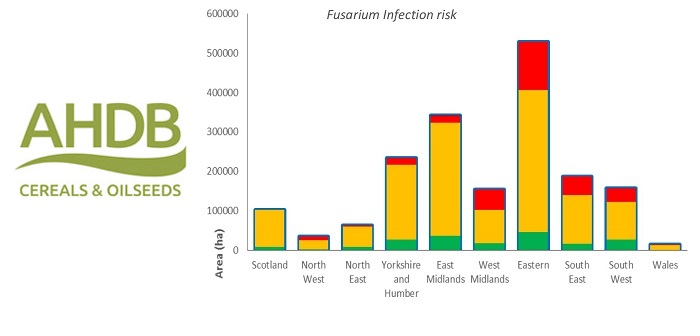Winter wheat growers in Britain have been alerted to an increased risk of mycotoxins entering the food and feed chain, compared with conditions in 2015.
Infection of crops by fusarium species increases the risk of mycotoxins entering the food and feed chain and, according to AHBB Cereals, around 73% of the GB winter wheat area was at moderate risk during this year’s flowering period with 17% of crops at high risk of fusarium infection.
This contrasts with the relatively low fusarium infection risk reported at the same stage in 2015.
“Due to the highly local nature of infection risk, growers are being reminded to follow mycotoxin management guidelines and to calculate field-level mycotoxin risk scores for recording on the grain passport,” said AHDB Cereals, who fund the monitoring work on which the warning is based.
AHDB’s Dr Dhan Bhandari, who manages the organisation’s grain quality research, added: “Flowering started at the beginning of June, when conditions were generally settled. The weather turned during the peak flowering period, which happened from the middle to the end of June.
“This exposed relatively large areas of winter wheat to conditions which favour fusarium infection.”
The largest areas of high-risk crops were in Cambridgeshire, Kent, Norfolk, Shropshire and Staffordshire. In addition, a small proportion of crops, located in Derbyshire and Nottinghamshire, were classified as being at very high risk of fusarium infection.
AHDB added that infection risk can be mitigated to some degree by a T3 spray and that the majority of the wheat area received a well-timed spray at the start of the flowering period.
“The important thing is to record what happened on the mycotoxin risk assessment and let the results guide your management decisions,” Dr Bhandari told growers.
“As part of your harvest plan, map out the potential mycotoxin risk across your farm. Group crops with similar agronomy that have been exposed to similar amounts of rain during the critical fusarium infection and spread periods.
“Where symptoms have been spotted in crops, adjust combines to minimise the retention of light fusarium-damaged grains and chaff.
“Crucially, at every opportunity, segregate crops according to their risk score. Once mixed, your power to control grain quality can diminish significantly.
“Once safely in the shed, calculate the final risk score and record it on your grain passport.”
Growers are also advised to check end-user requirements to determine whether mycotoxin testing is required and to plan their approach to grain sampling carefully.”


